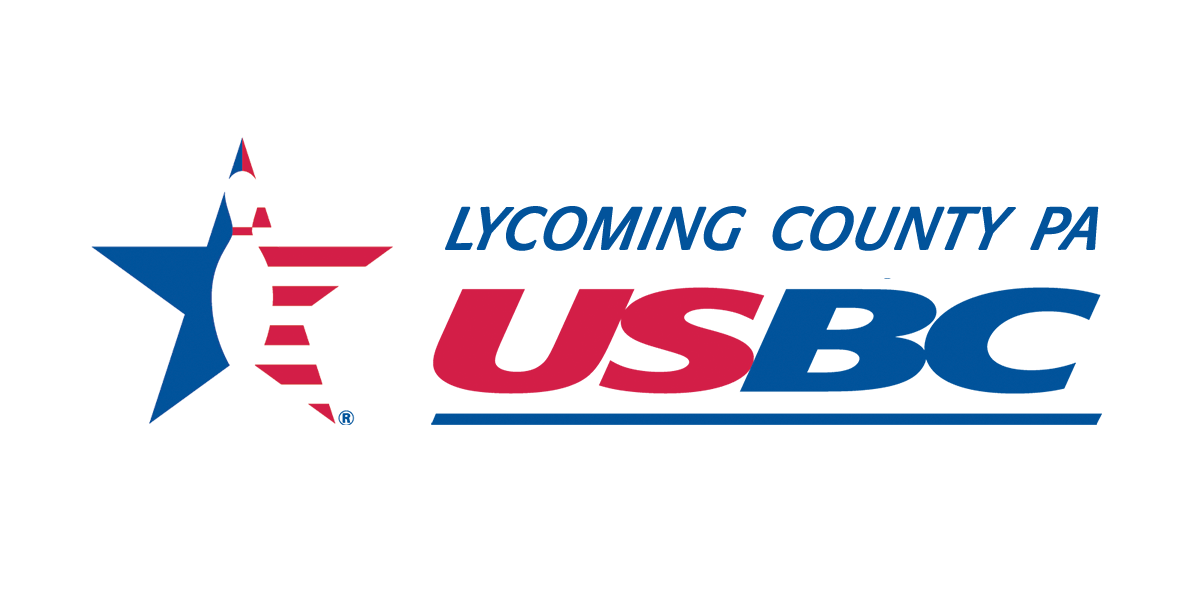History of Association
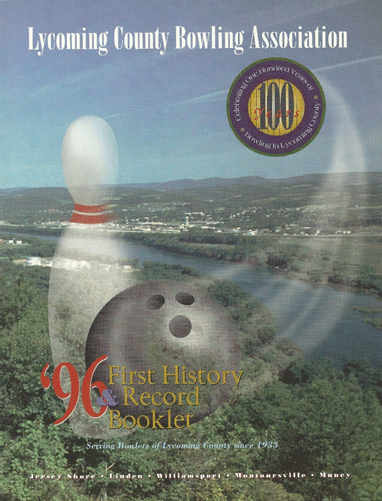
The front cover of the 34-page history booklet produced by the Lycoming County Bowling Association in 1996, written by Woody Crist. This Booklet covered local bowling history before 1960. The following pages basically contain Woody’s work, with some editing, and some additions, not only to record local bowling history beyond 1960 up to the more recent past, but also to include historical events in the local women’s association history since the original work included only the men’s association history.
“Golden Age of Bowling”
IN
WILLIAMSPORT/LYCOMING COUNTY
“The Beginning”
When did the game of ten pins first appear in Lycoming County?
Where was the first bowling alley?
When were the first automatic pinsetters installed?
Who bowled the first perfect “300” game?
For the answers to all those questions, and more on the history of bowling in Lycoming County, let’s return to the late 19th century, and relive what is referred to as the “Golden Age of Bowling”.
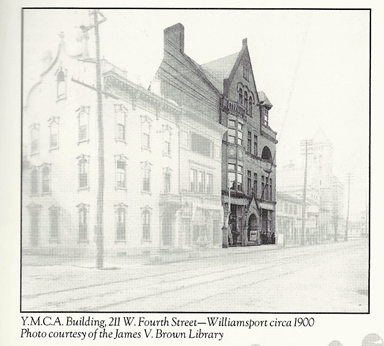
It was New Year’s Day, 1894, the Young Men’s Christian Association was formally dedicating its new 3-story addition at 211 West Fourth Street. With the installation of two bowling alleys in the basement, the sport had arrived in Williamsport. The YMCA was the “Birthplace of Bowling in Lycoming County”. The alleys were of Reisky and Wolf patent, 70 feet long, mounted on beds 49 inches wide and 3 inches thick.
Use of these alleys was limited to YMCA members only, which numbered 456 that year. Yearly membership for adults was $6.00, and $5.00 for students; both included use of the alleys. However, for just $2.00 a year you could bowl. Attendance records revealed that members were slow to partake of the sport, as only approximately 30 people per month bowled, even up until 1901.
1895 – On September 9th, after a 15-hour meeting at Beethoven Hall in New York City, the American Bowling Congress, known as the ABC, is founded. It creates and adopts rules that set the standards for the very basics of the sport: a scoring system, pin sizes and weights, and ball sizes.
The American Bowling Congress endured the test of time, celebrating its 100th anniversary in 1995. The ABC continued to govern the sport until 2005, when it merged with the Women’s International Bowling Congress (the WIBC, founded in 1918) and the Youth Bowling Congress, to form the United States Bowling Congress, known as the USBC.
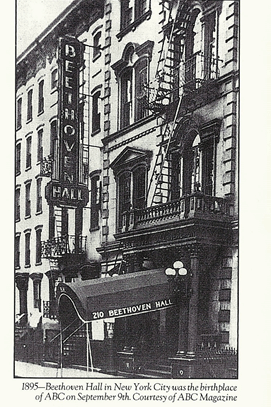
1900 to 1909
“League Bowling Begins”
The first ten years of the 20th century was highlighted by the start of league bowling, the opening of four new establishments, the development of two new innovations to the sport, and the beginning of local newspaper coverage of bowling.
1901 – On November 5th, the first league match is held at the YMCA, as the Business Men Team defeats the Bankers (1096 -1055) in a two-game match. Total pins determined the winning team, which was awarded one point. The league, referred to as the “Tournament”, consisted of four 4-man teams and bowled for 18 weeks. (Note that only 2 of the 4 teams could bowl at any one time since there were only two alleys. Such split league conditions occured in many of the early houses which seldom contained more than 4 lanes.) The Bankers, with a record of 12-6, outlasted the Press Team to win the championship.
On November 6th, the first newspaper article about bowling appears in the morning addition of the Gazette and Bulletin.
1902 – The first privately-owned alleys are opened by Lambert J. Casper at 344 Pine Street. Many exhibition matches were held in this two-alley house, as YMCA bowlers hosted teams from surrounding areas. It is not known if any league bowling took place there.
1904 – Two men, whose business was known as Donovan and Bressler, open the Battery Bowling Alleys at 322 Market Street and begin a career which spans over 32 years in the bowling business. The name of these alleys derived from the fact that the two men were baseball standouts playing for the Millionaires in the Tri-State League. Donovan was the catcher and Harry Bressler was the pitcher, thus forming a “battery”. Harry (Rube) was the cousin of the other Rube named Raymond, from Renovo, who is in Baseball’s Hall of Fame. Donovan and Bressler promoted the sport of bowling by hosting several leagues a week for five years until 1909, when they moved to 127 West Fourth Street and opened the Casino which they operated until the flood of 1936 forced their closing.
1905 – The first hard rubber bowling balls appear, replacing the wooden type made of lignum vitae, a hard wood so dense that it would not float, and also replacing a wood “particle” type ball marketed around the turn of the century. It is not known when the first hard rubber ball was used in this area, nor when the last wooden ball was retired.
A radical new advancement in bowling is introduced: the first “mechanical” pinspotter, the early forerunner of the semi-automatic pinsetter. Here again it is unknown whether any were in use in the Williamsport area.
1908 – For the first time in the Williamsport area, alleys are placed in a church, as two alleys are installed in the basement of Christ Episcopal Church at Fourth and Mulberry Streets. Bowling was very active, as in-house church leagues were formed from the congregation which numbered around 4000, the largest in the county. These alleys withstood the 1936 flood, and were used until the 1946 flood forced their removal.
1909 – The Williamsport County Club installs two alleys in the basement of its newly opened club house. These were the first local alleys outside the city limits. Bowling was exclusively for Club members, with these alleys seeing much activity until the late 1980’s. The alleys however were only 55 feet in length from foul line to the head pin. They featured the use of pin boys for the entire 82 years of operation, until they were demolished in July of 1991 making way for the newly adjacent club house.
1910 to 1919
“Poised for Change”
The second decade of the century featured the founding of the Williamsport Bowling League, which operated as the City League for the remainder of the century, and the opening of three new establishments, one of which was in Muncy.
1910 – Bowling at the YMCA is fading out. After viewing them as a ten-year-old boy, Dave Gross, first President of the local Association in 1933-34, recalled that “the alleys were almost black in color”. The K of C, better known as the Knights of Columbus took over the operation of these alleys at 211 West Fourth Street in 1919. The alleys were refurbished, and bowling returned with in-house leagues until the 1936 flood caused their removal.
1911 – The first alleys in the Muncy area are opened at 17 South Main Street. Known as McMurtie’s Alleys, they had billiard tables on the first floor, with two alleys in the basement. In 1912 they were sold and operated as Fahenstock’s Alleys until their closing in 1919.
1913 – John A McGee opens a wholesale operation of tobacco products at 240 West Fourth Street, adjacent to the Williamsport Sun-Gazette building at the northeast corner of Fourth Street and Hepurn Street. McGee’s operation also featured a soda fountain, a lavish 8-table billiard parlor in the rear, and two bowling alleys in the basement. It closed in 1923 due to McGee’s death.
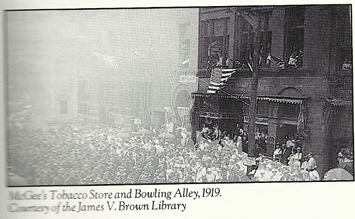
1916 – On November 29, the Women’s National Bowling Congress, which later became the WIBC (Women’s International Bowling Congress), is formed. The WIBC would continue to exist alongside of the ABC until 2005, when the United States contingencies of the two organizations would merge together to form the USBC (United States Bowling Congress).
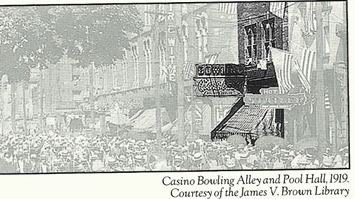
1917 – On October 15, the Williamsport Bowling League is founded, with twelve 4-man teams. It opened with bowling at both the Casino and McGee Alleys, on the same night. These two establishments jointly hosted the league for six seasons, with the league expanding to sixteen 5-man teams in 1921. In 1923 the newly opened YMCA Alleys, at 343 West Fourth Street replaces the McGee Alleys in rotation. For two seasons the YMCA and the Casino host the league, until, in 1925, the YMCA becomes the exclusive host until their closing in 1982. Known as the City League after a name change, this league becomes the oldest sanctioned league in county history, and moves to the Montour Lanes, where it continued its operation on Tuesday nights until Montour’s closing in 2006.
1919 – Two alleys are placed in the basement of the Apker’s Motor Car dealership at 1955 Newberry Street in the west end of the city. The extent of their use is unknown, as they were lost to fire in 1924.
1920 to 1929
“Sanction Bowling Arrives”
The 1920’s, better remembered as the “roaring twenties”, began with the Prohibition era and ended with the beginning of the “great depression”. Six new local establishments open, tournament bowling begins, the first local team bowls in an ABC Tournament resulting in sanctioned bowling locally, and women take to the alleys for the first time. Local bowling standouts emerge, and new scoring marks are established.
1920 – When the National Prohibition Amendment goes into effect on January 16th, the ABC is in its 26th year, and membership had increases nearly 100% from the 1918-19 season to 5100. By the end of the 1920’s, membership soared to 44,000. Bowling alley operators discovered that bowlers came to bowl, not to drink.
1923 – The YMCA dedicates its newest facility at 343 West Fourth Street on September 9th. With five new alleys in the basement, the “Y” becomes the first local establishment to have more than two alleys. They are under the control of 23-year-old alley master, Tommy Barger, Sr. His career in the sport would endure for over forty years, and earn him the title of “Mr. Bowling” for his fostering of the game. Four more alleys would be added in 1929. The great 1936 flood would cause $35,000 in damage to these nine alleys, which would be replaced by 15 new alleys, which would, in turn, be destroyed by the 1946 flood. In 1947, eighteen alleys were opened on the first floor. They were laid out back-to-back, with alleys 1 through 8 on the north side, and alleys 9 through 18 on the south side. For many years, the Williamsport YMCA boasted the largest YMCA bowling center in the state. The YMCA would close these bowling lanes in the spring of 1982.
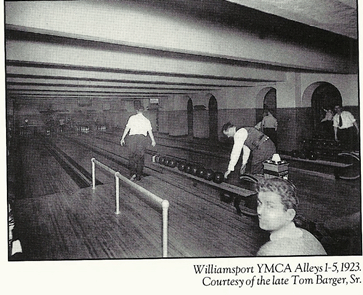
The Jersey Shore YMCA opens two bowling alleys at 826 Allegheny Street. In 1932, bowling moved to the first floor, as this establishment expanded and installed four alleys. In 1941, four more alleys were added.
H.R.B. Jones, known as Herb Jones, installs two alleys on the first floor at 2000 Newberry Street in the west end of the city. Known as Jones’ Alleys by the bowlers, they are called the Newberry Alleys in the newspaper. Adjacent to the alleys on the first floor was a billiard parlor and on the second floor was the Radio Club, a seller of “spirits”. These alleys closed in 1934. Boarded over, they remained in place into the 1990’s.
1924 – Lycoming College places three alleys in the basement of Recreation Hall. For many years, college leagues were active, until the 1950’s when bowling was made part of the gym classes. The lanes were removed in 1981, to make way for a new building.
The Susquehanna Trail Tournament starts on April 21st and runs until May 3rd. The first ever held locally, it attracts 26 teams, 59 doubles sets, and 106 singles from central Pennsylvania. The event which was hosted by the Williamsport YMCA, is considered to be the early forerunner to the Annual Association Tournament which began in 1935. The Trail tournament stopped in the mid 1960’s.
1924 – Lycoming College places three alleys in the basement of Recreation Hall. For many years, college leagues were active, until the 1950’s when bowling was made part of the gym classes. The lanes were removed in 1981, to make way for a new building.
The Susquehanna Trail Tournament starts on April 21st and runs until May 3rd. The first ever held locally, it attracts 26 teams, 59 doubles sets, and 106 singles from central Pennsylvania. The event which was hosted by the Williamsport YMCA, is considered to be the early forerunner to the Annual Association Tournament which began in 1935. The Trail tournament stopped in the mid 1960’s.
1925 – On March 23rd, the Morgan’s Clothier Team becomes the first team to bowl in an ABC National Tournament. They compete in the 25th ABC Tournament in Buffalo, N.Y. and roll a 2691, ending up in 259th place and cashing for $24.00. The six men are issued sanction cards at the e tournament for $1.00, making them the first team to be sanctioned from Lycoming County. The entire City is also sanctioned for the 1925-26 season. For the 1926-27 season, the City League pays the dues of $16.00, or $1.00 per team, to the ABC.
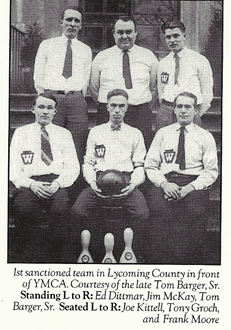
On November 14th, at Jone’s Newberry Alleys, the Williamsport Keystones roll the first 1000 game ever bowled locally. They are the same team that rolled in the ABC Tournament eight months earlier, with the exception of Dave Gross, who was the sixth man that night. They recorded a 1012-1066-913 for 2991, the highest series ever hit locally up until that time.
1926 – The Morgan team of the City League rolls the first sanctioned 1000 team game, a 1032, on February 17th.
On December 24, while bowling in a doubles tournament at the YMCA, Tommy Barger, Sr. bowls a 799 series. This was the best series ever bowled locally up until that time and, according to an article in the Grit newspaper on December 26, 1926, it surpassed a 729 series bowled the previous year by Phil Philcott. (It is not known whether that was during the spring of the 1925-26 season or sometime in 1925) Although it is fairly clear that Barger’s series was bowled in an official competitive match, whether it was a sanctioned tournament or not, it can only be assumed that Philcott’s score was achieved under the same conditions, and that both men should be credited with having held the official local record at the time their series were bowled, given the fact that sanctioning was in its infancy at that time.
At some point during the 1926-27 season, Ann Gilmore became the first woman ever to bowl locally. Women wern’t allowed into alleys in those days, however Tommy Barger let her try after the leagues were over. She knocked down just three pins on her first attempt. Another local account credits Elizabeth Morgan and Ruth Dittmar with accompanying Gilmore in this original female bowling endeavor. It seems that Ditmar was the YMCA secretary, and Gilmore and Morgan would meet Dittmar at the YMCA after she finished work, and all three women talked Barger into allowing them to bowl. It was estimated that only about 3000 women were bowling in the U.S. at that time. Soon after that first night, many local women followed and in 1929 the first women’s league (non-sanctioned) were formed in Williamsport.
1927 – The Elk’s Lodge B.P.O.E. #173 opens four alleys at 36 East Fourth Street, across from the James V. Brown Library. In 1949, the Club was modernized with the installation of the first alleys in the Eastern U.S. with range finders. They also put in foul lights and air conditioning. The Elk’s had many leagues a week for nearly forty years, before the facility was sold in 1972. The alleys, however, remained at the site until 1988.
The first bowling shoes appear. An inspired young Barger, after returning from the 1927 ABC in Peoria, noticed that tournament bowlers were wearing their own bowling shoes. After working with John Jacobs’ father, owner of JF Dayton Shoe Co. across from the YMCA, the first bowling shoes in Williamsport, were manufactured. By 1930, bowling shoes replaced street shoes, eliminating the need for daily cleaning of the approaches to remove heel marks.
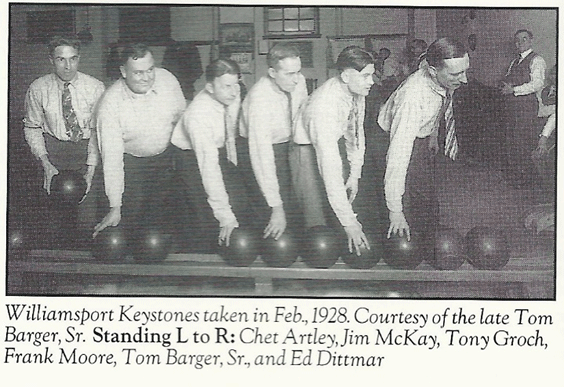
On February 14th, the Keystones establishes a new City record by rolling the first 3100 series, a 3134 (1010, 1054, 1070), in the Central Pennsylvania traveling League at the YMCA.
Just three weeks later, on March 5th, the Keystones break their own record and hit the first 1100 team game ever. They roll a 3144 (997, 1115, 1032), a series that was higher than any that had been bowled in the twenty-six-year history of the ABC Tournament, again in the Central Pennsylvania Traveling League at the YMCA Alleys.
Just two days later, on March 7th, the first exhibition ever held locally features ABC Champion Billy Knox of Philadelphia. Elected to the ABC Hall of Fame in 1954, Knox was the first man to roll a 300 game in ABC Tournament history in 1913, and won the ABC All-Events in 1923 with a record 2019 that stood for ten years. A crowd of 250 spectators viewed the exhibition as Knox bowls 6 games- 3 singles matched, losing them all, and 3 doubles, winning one. Later local exhibitions featured the legendary Andy Varipapa (April14, 1934) at the YMCA Alleys, the Ballentine Beer Team of Scranton (1953), which included Frank Clause and George Billick, Buddy Bomar (1960) and Ray Bluth (1962) both at Faxon, Buzz Fazio (1963) at the Elk’s and Sylvia Wene (1961) at the Harvest Moon.
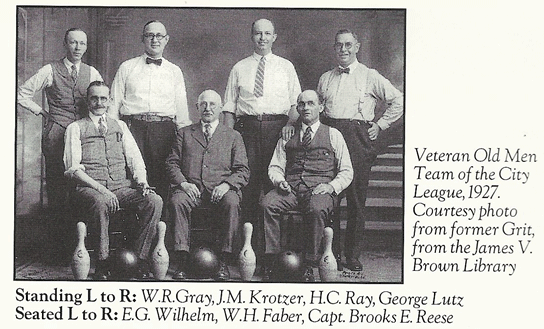
As the 1926-27 season ends, Joe Kittell becomes the first man to crack the 190-average mark, finished the season with a 192 average in the City League.
1928 – The Sportsdrome opens at 251 West Third Street, across from the Grit Building. The six alleys, which are on the second floor, are managed by Charles Classer, proprietor. Adjacent to the alleys were pool tables and a card playing room. For many years, they hosted several leagues and many tournaments.
1929 – On November 5, the first women’s league begins league play. Other women’s leagues follow. These leagues bowled during the day since men’s leagues already took up the lanes at night. The women often set their own pins since there were few pin boys on the premises during the day. Women only bowled two game sets rather than the three game sets bowled by the men, and at times, everyone on one team used the same alley ball because there were few balls that women could effectively grip. It would been more than another 10 years before the first women’s leagues were sanctioned under the Women’s International Bowling Congress.
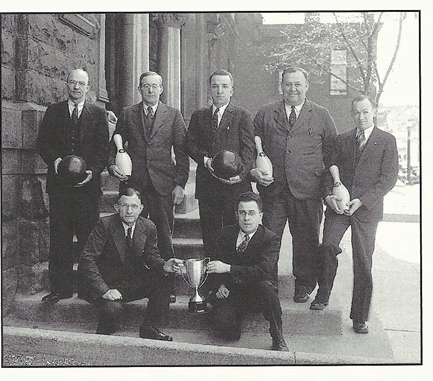
Kolb’s Team, champs of the Keystone League in front of the Sportsdrome.
Holding the cup is Charlie Glasser (L) and Chet Breon (R)
Standing L to R: Stutman, Moore, Gross, McKay and Root
Courtesy of Grit Publishing, from the James V Brown Library
1930 to 1939
“The Williamsport Bowling Association Is Founded”
The decade of the 1930’s, better known as the “Depression Years”, was highlighted by the chartering of the Williamsport Bowling Association, the hosting of the first state tournament in Williamsport, and the occurrence of a great disaster to bowling – the 1936 flood. Two new establishments open, a variation of the sport (called “Duck Pins”) organizes, new scoring marks are achieved, women take to the lanes, and bowling’s first “Super Star” emerges.
1930-33 – Despite the fact that the “Depression Years” are hard times in the Williamsport area, with one out of every four workers being unemployed, and the city being reported by the Chamber of Commerce, in 1933, as the hardest hit area in the state, bowling still grows locally, despite a 33% decrease in ABC membership.
1930 – The Junior Mechanics Hall (Order of American Mechanics) opens at 31 North Main Street in Muncy with four alleys in the basement. They remain there until the 1936 flood, after which they are re-installed on the first floor. The Hall closes in 1945. The Sprout Waldron League was founded here.
1931 – On January 1st the Masonic Hall opens three alleys in the basement at 352 ½ Broad Street in Montoursville. They host the 16 team Montour League from 1932 to 1953, when the alleys close and the league disbands.
1932 – In September the Williamsport Duck Pin League is organized, comprised of six teams which bowl on Friday nights at the Williamsport YMCA on alley 1. The statistics for the 1932-33 season, presented by league secretary Frank Cromis, shows that 69 bowlers participated in 2253 games that first season, crashing the pins for a grand total of 276,636 pins. John Jacobs took high average with 154. Lycoming Printers were league champs with 78 wins. Duck Pins were also played at the Sportsdrome and the ABC alleys. They disappeared in the mid 1950’s.
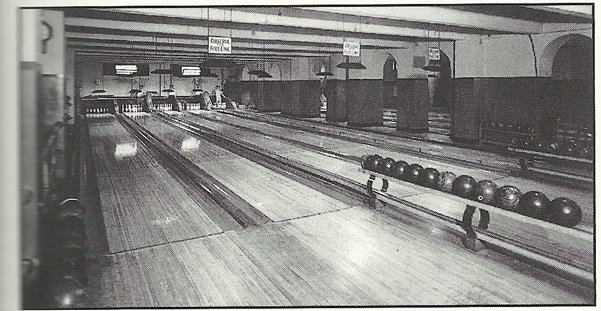
YMCA Alleys features “Duck Pins” on alley 1, 1935
Courtesy of former Grit, from the James V. Brown Library
1933 – In the summer, the Williamsport Bowling Association is chartered by the American Bowling Congress with David E Gross being elected as its first President. His undaunted efforts for many years credits him for its founding. The original charter, which was displayed at the YMCA, was destroyed in the 1936 flood.
1934 – On February 27th, the first State Tournament ever held locally opens at the Williamsport YMCA. Called the Pennsylvania State YMCA Tournament, it attracts 100 teams. The Keystone Taxi Team of Williamsport were the first champions with a score of 3790 for four games. They were presented with the prestigious Grit Trophy, and their names were inscribed on the Grit Plaque, to which each successive year’s champions are added. The Grit Plaque was displayed at the YMCA. Four other local teams would win this tournament (Williamsport YMCA/Plankenhorn’s Candy (1939), Millers Pastry Shop (1941), Williamsport YMCA (1942), and Flexer’s Lunch(1943)) before the tournament was disbanded in 1944.
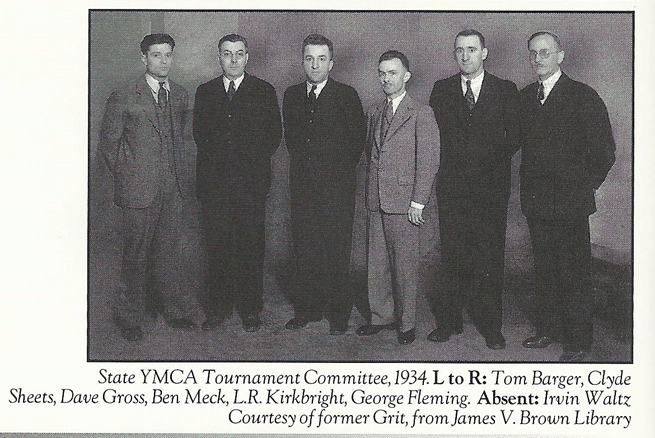
At the conclusion of the 1933-34 season, Joe Kittell, in the City League, establishes a new local record for high average. He averaged 208.3 for 90 games, nosing out John Jacobs (who averaged 207.8) by a mere 50 total pins. They were the first two local bowlers to average 200 or better for an entire season. Kittell’s mark stood for 26 years.
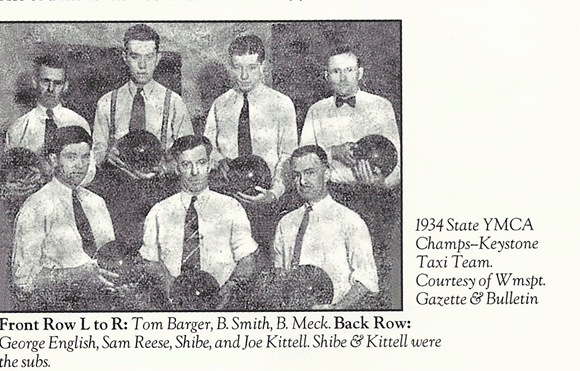
1935 – On April 22nd, the Williamsport Bowling Association holds its first Annual Championship Tournament, which supplanted the annual Susquehanna Trail Tournament. It runs until May 4th, attracting 53 teams. Danville YMCA were the first team champions, while Ralph Kelchner won doubles, singles, and all-events.
The YMCA closes for the summer on May 15th to install new gutters to meet ABC specifications and to re-coat with 6 layers of shellac.
On Saturday, May 5th, Joe Kittell enters the record books by rolling the first sanctioned 300 game in local association history, in the Susquehanna Valley Traveling League at the Williamsport YMCA alleys. He placed his perfect game between a pair of 234’s, just missing his own series record of 786, achieved in March of 1934. Kittell’s perfect game, which was bowled in a sanctioned competition, upstaged the 300 game bowled by Henry Parsons Jr. a few months earlier on January 12, which occurred in an exhibition match, also at the YMCA, which game was apparently not sanctioned.
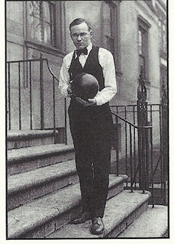
The YMCA closes for the summer on May 15th to install new gutters to meet ABC specifications and to re-coat with 6 layers of shellac.
Joe Kittell standing on the steps at YMCA, 1931
Courtey of former Grit, from J.V. Brown Library
1936 – On March 18th the Susquehanna River crests at 33.9 feet, flooding two-thirds of the industrial and business district. It created a great disaster locally for the sport of bowling, especially since most alleys were located in basements. The YMCA Alleys were completely destroyed, with $35,000 in damages. The Elks’ four alleys as well two alleys at the K of C were destroyed, and the Cassino closed for good. However, Christ Church was able to save its two alleys. In Muncy, the Mechanics Hall eventually moved its four alleys to the first floor. The YMCA opened fifteen new alleys in September, but the Elk’s Club did not dedicate its new alleys until September 26, 1938. In all, six establishments with 23 lanes, were affected.
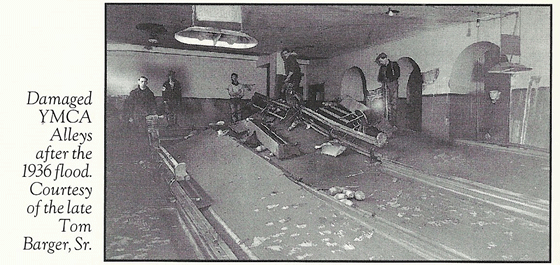
1938 – On St Patrick’s Day, March 17, Joe Kittell astonishes the local bowling community by rolling the first 800 series in the area. He rolled an 825 on games of 247, 279, and 299, in the Montour League at the Masonic Lanes. It was believed to be the 13th highest sanctioned series ever bowled in the nation at that time.
1940 to 1949
“Technology Forces Change”
The 1940’s, remembered as the “War Years” (1941-45), was an era which had the most profound impact on the sport, and also saw new technology give way to old traditions. The women organize and receive a charter from the WIBC, four new establishments open, and an organization is formed which recognized bowlers who roll a 700 series.
1940-41 – ABC gives free sanction and certification to all military leagues and establishments. The move proves popular as the government installs 4,500 alley beds worldwide during the Second World War.
1941 – The American Bowling Center, known locally as the ABC Lanes, at 1245 Park Avenue, opens in early January, and is dedicated on February 21st. With 16 alleys located on the first floor, the ABC Lanes, owned by Louis Foreman, becomes not only the largest set of alleys in the area, but also the first local establishment built from the ground up, with bowling as its intended use and main attraction. Prior to 1941, local bowling alleys had been constructed primarily in basements, and primarily in sets of two or four, as a side attraction to the main, existing business operations on other floors of existing buildings. A small footnote to history: the first “pin boy strike” took place at the ABC Alleys. The dispute was quickly settled when the owner gave them a 1cent per line raise, to 5 cents a line, which was what the pin boys at the YMCA were making.
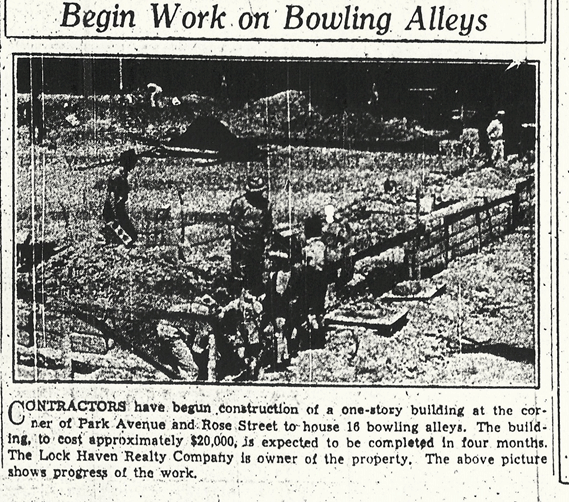
Construction of the ABC Lanes in 1941
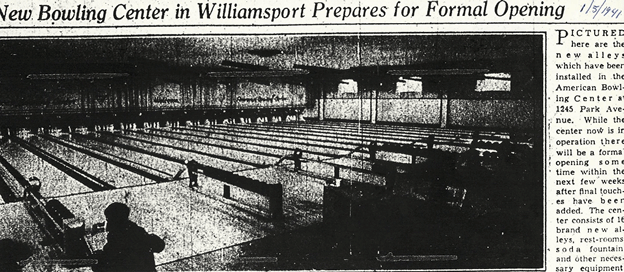
ABC Lanes in 1941
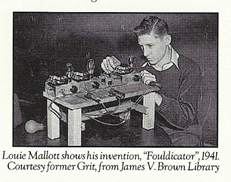
On April 6th, 16-year-old Louie Mallott, a pin boy at the YMCA Alleys, goes public with his invention, the “Fouldicator”, which met the desire of the American Bowling Congress to have an automatic foul indicator which put a beam across the foul line and up the wall. Mallott built his device for a total cost of $65.00, and received much attention from bowling manufacturers including Rosati-Barry of Philadelphia, a large east coast distributor. A patent cost $300.00 which Louis Miele, Sr., a local amusement business owner, wanted to pay, but young Mallott would not release his secrets. On November 11, 1944, ABC approved a device called the “Fouldicator”, which employed the exact principles that Mallott had invented three years earlier. In 1948, ABC approved the single beam device which replaced the “Fouldicator”, a unit that was never manufactured in quantity. Before installation of automatic foul lights, fouls were determined by the witness of participating bowlers, or foul judges who stood to the side of sets of alleys looking down the foul line and judging whether a bowler had gone over the foul line during a delivery.
On May 18th, the Moose Lodge completes installation of the newest mechanical device, the first “Semi-Automatic Pinsetter” in the area. Lester Kirkbright is the first alleymaster for the six new alleys which were opened in January. The 1941-42 season is the beginning of sanctioned bowling in the Moose Lodge #145. At the time of their closing in 2006, the Moose Lanes held the distinction of hosting the oldest sanctioned Moose League in the nation, the Moose “A” League, which began in 1941.
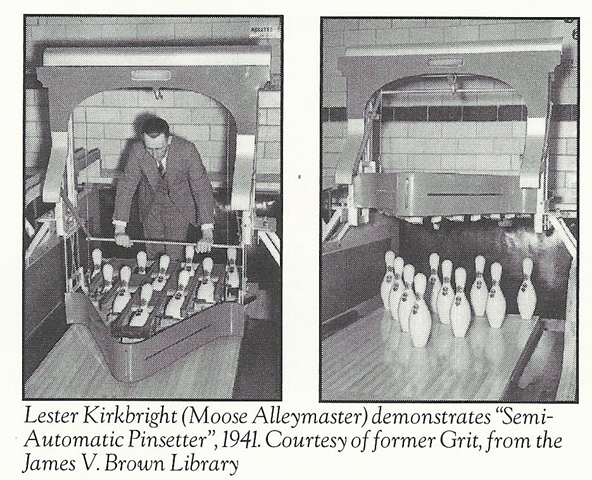
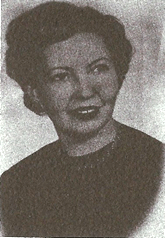
In July, the Williamsport Women’s Bowling Association (WWBA) is chartered under the auspices of the Women’s International Bowling Congress. With 200 members, this local association became the largest women’s association in the state of Pennsylvania. Martha Strayer is elected President for the 1941- 42 season.
Martha Strayer – first President of the
Williamsport Women’s Bowling
Association
1942 – On March 3rd, the American Bowling Congress opens its 42nd annual tournament in Columbus, Ohio, the last such tournament until 1946, after World War II. 1943 would be the last time that the ABC cancelled its annual event.
1943 – The Pennsylvania State Women’s Bowling Association Tournament takes place in Williamsport. So overwhelmed by the enthusiasm of the newly formed WWBA, the PSWBA votes to hold its 1943 state tournament in Williamsport, hosted by the local women’s association in only its second season of operation. This was the first ever State Association tournament ever hosted by a Williamsport association. The tournament was held at the ABC Lanes, and drew the largest number of entries in tournament history, up to that time. Of interest is the fact that some tournament participants arrived by train, and members of the WWBA hospitality committee had the job of meeting these out-of-town bowlers at the train depot, and finding them accommodations. At that time the Williamsport Train depot was located at the south end of Pine Street, in the area now occupied by the beltway. Travel by train to the state tournament may have been common in those days, before the advent of four lane interstate highways after 1960 made car travel much easier. But the gasoline shortage during these war years might well have increased train travel at that time.
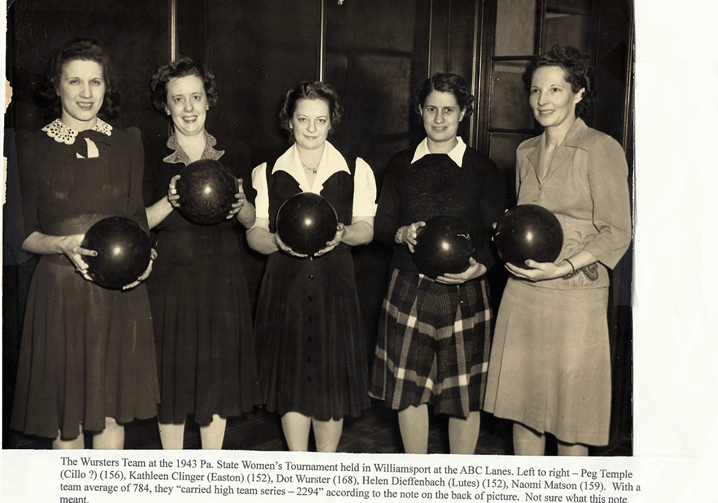
The VFW Post 3428 opens two alleys in the basement at 21 South Main Street in Muncy. For many years, in house veterans’ leagues, as well as sanctioned leagues operate. The alleys were flooded in 1946, and replaced. In 1962, the alleys were removed and sold, when the VFW moved to a new facility.
1946 – On January 28th, the 700 Club of America grants a charter to the local Chapter 11 of the 700 Club. Joe Kittell is elected King Pin (President), and Harvey Tressler, Sr. Pin Boy (Secretary) of the local club which had 13 charter members. The 700 Club, the dream of Fred j. Lipovetz, a professor at La Crosse University in Wisconsin, was opened only to ABC members who had rolled a sanctioned 700 series.
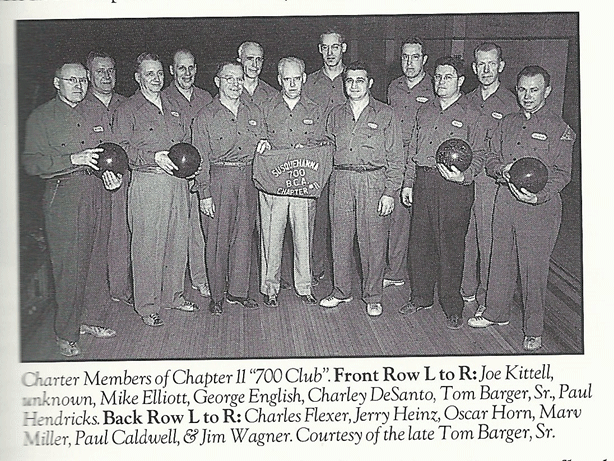
On May 28th, disaster struck bowling with another great flood when the Susquehanna River crested at 30 feet. Five establishments were affected with a total of 29 lane beds. The YMCA Alleys (15) were destroyed, the Moose (6) were put up on their sides and dried out all summer. The four Elk alleys, the two Christ Church alleys, and the two Muncy Vets alleys were destroyed. As a result, bowling ended at Christ Church.
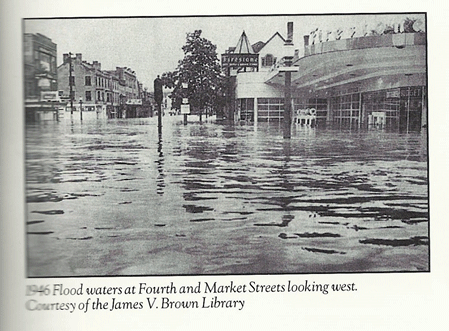
The American Junior Bowling Congress (AJBC) is founded as an ABC and WIBC co-sponsored organization. The roots of junior bowling began in 1936 when Milt Raymer, a Chicago high school teacher organized an intermural league which soon spread city-wide. The program expanded nationally by 1945 as the National Bowling Council provided financial support, and became the AJBC a year later.
1947 – The Williamsport YMCA opens 18 new alleys on the first floor which gives them the distinction of having the largest bowling facility in Pennsylvania. These alleys were laid back-to-back with 1 through 8 on the north side and 9 through 18 on the south side, the two sides being separated by about a 20-foot raised floor area accessing spectator seating on both sides.
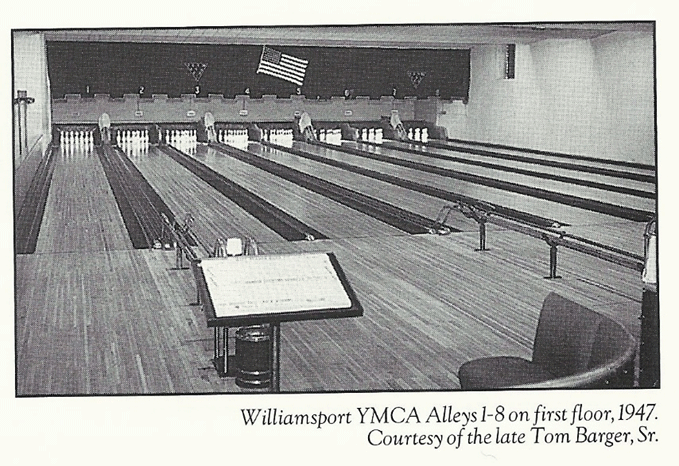
(Note the scorekeeping table and the white chalk block. Scores were kept by hand on the approximately 36-inch X 18-inch scoresheet which contained enough frame lines to keep the score of two five-bowler for one game, after which game the used scoresheet would be ripped off at the top of the scoresheet tablet to reveal the scoresheet below to be used for the next game. The conically shaped chalk block had a vertical hole running down through the middle. A bowlers could stick his thumb in the hole and move it around the surface of the block, to get rid of moisture before , throwing the ball. Note also the cigarette can between the score table and the ball return.
Bowl Arena opens with 10 new alleys at East Water Street, in Muncy under the ownership of George Wilt. The establishment changed its name to Cloverleaf Lanes occasioned by the construction of the four lane I 180 highway, which included the positioning of the only cloverleaf interchange in the county adjected to the lanes.
1949 – On July 3rd, the Williamsport YMCA completes installation on the new electric foul lights at a cost of $1800.00. They were the first of two area establishments to install them.
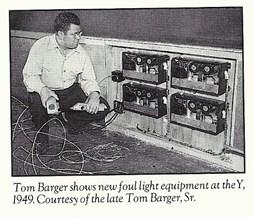
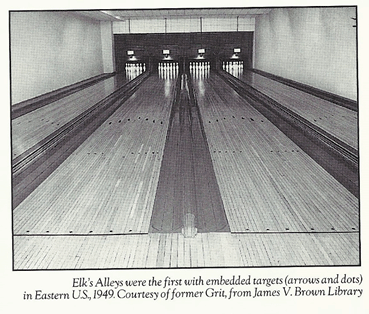
On August 7th, the Elks completes installation of their four new lanes, which featured the first lanes to have range finders (arrows) in the Eastern United States, after approval of these embedded targets by the ABC in 1946. The Elks Lanes also had foul lights and air conditioning.
Probably in the fall, Tommy Barger starts the junior bowling program at the YMCA, with four youngsters, perhaps the first junior bowling in the state, as he encourages other bowling establishments throughout the state to start a similar program. By 1952, there were 7000 tean-agers bowling in the state, including 500 in the Williamsport area.
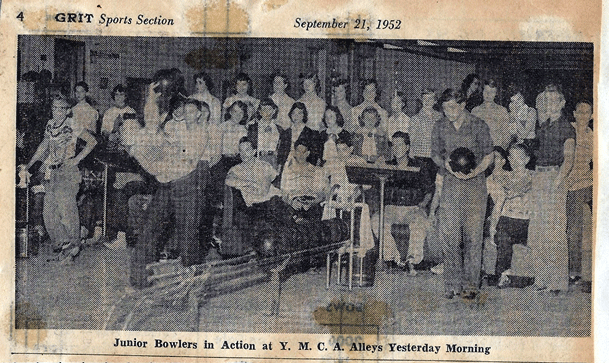
1950 to 1959
“Pinsetters Change the Sport”
The fifties, described as “The Bowling Boom” saw sanctioned membership soar and two larger establishments installed. Automatic Pinsetters appear, the bowling pin is improved, the Williamsport Bowling Association conducts a record tournament, and four new establishments open.
1950 – The Community Bowling Center on Route 54 opens with ten lanes under the ownership of Max Cole. During its 15 years of operation, this center hosted the Annual Association Tournament in 1954 and 1958. These alleys were destroyed by fire in 1965.
In September, the first black bowling team is sanctioned by the American Bowling Congress. Locally the Bethune Douglas Team, bowling in the Church League at the ABC Lanes, became the first all-black team to be sanctioned in Pennsylvania.
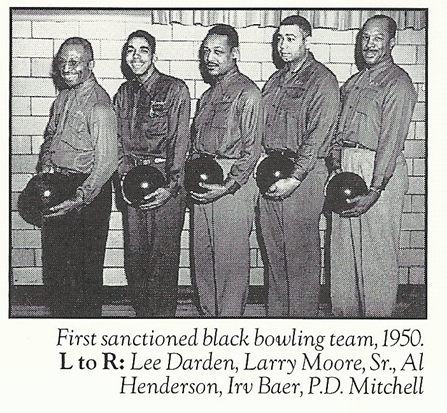
Williamsport hosts the initial Sylvania Bowling Tournament, drawing employees of Sylvania plants basically throughout Pennsylvania, annually to the Williamsport area. With an initial turnout of 140 bowlers forming 28 team entries, 53 doubles entries and 105 singles entries, the tournament would grow, by 1975, to attract 635 bowlers, forming 127 teams, 305 doubles entries, and 608 singles entries.
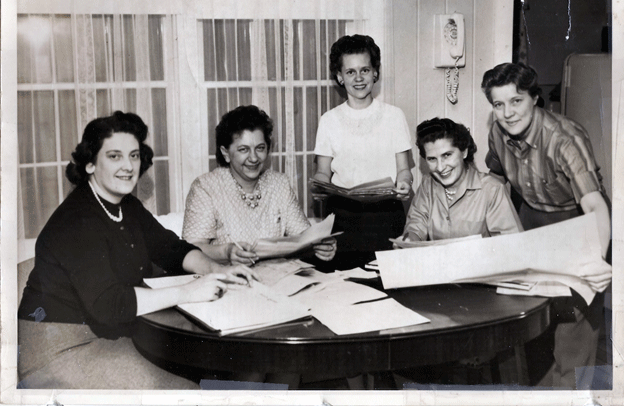
1957 Sylvania Tournament Committee: L. to R: Ida DeRemer, Caroline Havlicek, Joe Wilde, Florence Christy, Ruth Eck
1953 – On April 10, Robert Stover becomes the second local bowler to bowl a sanctioned 300 game, accomplishing that feat at The Bowl Arena Lanes 18 years after the first sanctioned perfect game was achieved. In the next 11 years, 12 additional local bowlers would each bowl one perfect game, before that feat would be achieved more than once by the same bowler.
In September, Kegler’s Korner begins in the Williamsport Gazzette and Bulletin. A weekly column which appeared every Tuesday during the bowling season, Kegler’s Korner was written by Gazette employees Pete Weaver and Nelson Silverstrim Jr., but was soon taken over by the Newspaper’s regular sports writer. In 1954, the column was changed to feature the men’s and women’s “Bowler of the Week” winners for each week that the article ran. Each of these winners was invited to participate in the newly created Bowler of the Year Tournament, at the end of the season. On October 5, Floyd Welshans was named the first Bowler of the Week, and the following week, October 12, Helen Eaton was named the first female Bowler of the Week. Gene Huss and Irene Walsh won the first Male and Female Bowler of the Year Championships at the end of the 1954-55 season. Kegler’s Korner would continue to be a regular feature in the local paper through the year 2000, when Sun Gazzete sportswriter, Lloyd Phillips, who had written the article for many years, retired.
At the end of the 1952-53 season, the Vaughn Baking Company announces that it will provide an “Oscar” for the bowler in the Williamsport Bowling Association with the highest league average at the end of the season. George Haas wins the Oscar with a 190.5 average. This award was called the Vaughn Oscar and was awarded again at the end of the 1953-54 season before transitioning in 1955, into one of several seasonal performance awards created by the Board of Directors to be awarded by the Association at the end of each season.
1954 – In November, the ABC approves the first plastic coated bowling pin. This approval comes after the Congress had conducted tests across the nation, beginning in 1948 and involving 190,000 games of controlled open play and more than one million games in league play. That same year a plastic pin base attachment was also approved by the Congress. The plastic formula was developed by Henry W. Moore of Omaha, Nebraska.
1956 – In June, the ABC Lanes completes installation of the first Automatic Pinsetters in Lycoming County. They were the AMF 4400 Series. AMF had developed its first automatic pinsetting machine in 1946, which was viewed at the ABC Tournament in Buffalo. That device, however, proved to be too cumbersome. In 1949, AMF marketed their improved model which was entirely different in design and concept. In 1957, the ABC installed pinsetters at its Tournament in Fort Worth, the first time in the history of the ABC Tournament that automatic pinsetters were used.
Turn-Verin (Turners) opens six new alleys in the basement at 327 East Third Street.
1957 – In April, the Susquehanna Chapter “600” Bowling Club is chartered by the WIBC. The Club, which took in the region extending from inside Harrisburg to inside Altoona, included 14 local women as its charter members. Local bowler, Dot Bluhm, was elected as the Club’s first President.
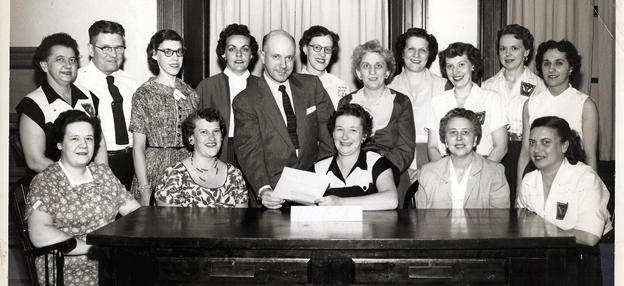
Charter Members of the 600 Club: Seated L to R: Evelyn Menier (Sec/Tres), Mary Corter (1st V.P.), Dot Bluhm (Pres.), Dorothy Kast (2nd V.P.), and Mary Bixler (Sarg-at-Arms). Standing L. to R: Caroline Havlicek, Tommy Barger (YMCA Alley Master), Roxie Larson, Mary Walton, Bob Griffin (700 Club Pres. Presenting Charter), Jo Ann Thomas, Catherine Henry, Peg Temple, Claudia Garvarick, Irene Walsh, Jennie Marino.
The Park Lanes opens at 736 West Fourth Street in a former movie theater. These 12 lanes were equipped with AMF 5850 Series automatic pinsetting machines, and hosted the Park Lanes TV League. Harvey Tressler Jr. was the lane manager until the lanes closed in 1967.
On November 16, junior bowler, Rickey Strothers bowls a 744 series in the Williamsport Exchange Club Junior Boys’ Bowling League at the YMCA Lanes, to lead his Bethune Douglass team to a 3006 team series which is nationally recognized by the American Junior Bowling Congress. Strothers’ series set a new A.J,B.C. record.
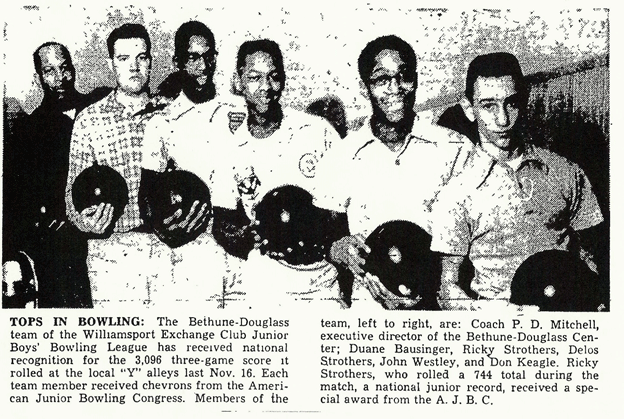
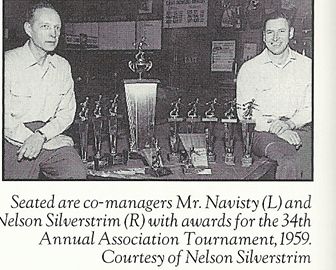
1959 – On February 7th, the Williamsport Bowling Association opens its 34th Annual Tournament at the ABC Lanes, which runs through February 22nd . The event, run by tournament managers Nelson Silverstrim and Mr. Navisty, drew 126 teams, setting a tournament record which has yet to be broken.
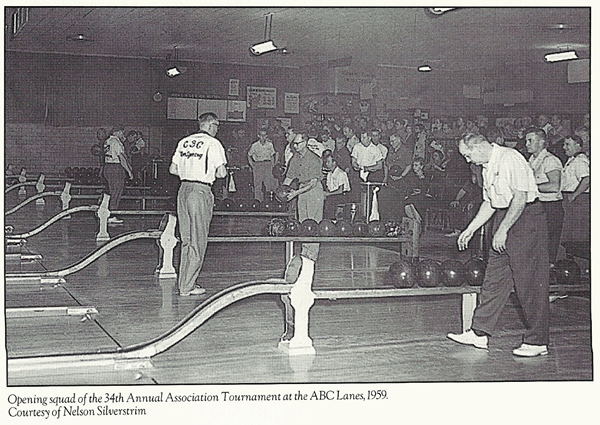
On June 3rd, the Williamsport YMCA begins installation of eighteen AMF Automatic Pinsetters. The YMCA had used pinboys for the entire 36 years of operation at that site at the corner of West Fourth Street and Elmira Street.
In July, Faxon Lanes at 1750 East Third Street holds opening ceremonies dedicating its 16-lane Center. It features sixteen AF-1 Brunswick machines, underground ball returns and overhead electric telescores – the first in the area. (The telescore system included a disposable see-through score sheet on which scores are written by hand, frame by frame with a pencil having a wax-like core. These score sheets overlaid a glass plate with a light underneath, allowing the image of the sheet to be projected into an overhead mirror unit which then projects the image unto a viewing screen suspended over the foul line above the bowlers’ heads. These telescores would remain the predominate scorekeeping system until the late 1990’s, when automatic score keeping became available. Faxon Lanes would remain at this location until they were destroyed by fire in 1967.)
1960 to 1969
“Association Membership reaches its zenith ”
The 1960’s see bowling continue to boom as Association membership continues to grow and then unfortunately began to decrease, a trend that continues into the 2000’s. Williamsport hosts its first men’s State Tournament, one new establishment opens, four establishments close and one more burns to the ground, only to rises from the proverbial ashes just down the street. Alleys get a verbal refurbishment, the Lycoming County Association Hall of Fame is established, ABC mandates the seasonal average book, and one local boy does very well on the national and international scene.
1960 – In November, local bowlers, Nelson Silverstrim Jr. and Irene Walsh win the men’s and women’s North Central Pennsylvania Match Game Championships, respectively, winning spots in the State Match Game Tournament in Shillington. With 94-3 points, Silverstrim breaks the Peterson point record for the four-year-old North Central Pa. Tournament, which record had been previously held by local bowler, Robert Stover who compiled 92-27 points in 1957. Walsh, who would be inducted into the WWBA Hall of Fame in 1975 under her married name, Lebada, had won the North Central Pa. Tournament the previous year, and finished fourth in the state tournament, qualifying her to compete in the National All-Star Tournament in Omaha, Nebraska. She would win this North Central Pa. Match Game Championships again in 1961,63 and 64.
1961 – The Harvest Moon Lanes along the new four lane 220 highway section in Linden opens its doors on 16 lanes with new Brunswick automatic pinsetters.
1962 – On March 2, Mark Guinter and Irwin “Pete” Weaver roll a 1332 in the Doubles Event of the ABC National Championship Tournament in Des Moines, Iowa. a score which moves them into first place. They remained in that position for 21 days, but eventually finished in third place. This is the highest finish in an ABC National Tournament event by a Lycoming County entrant up to that time, moving ahead of Tommy Barger‘s and Joe Kittle’s seventh place finish in the doubles event in 1927 at Peoria, Ill with a 1291.
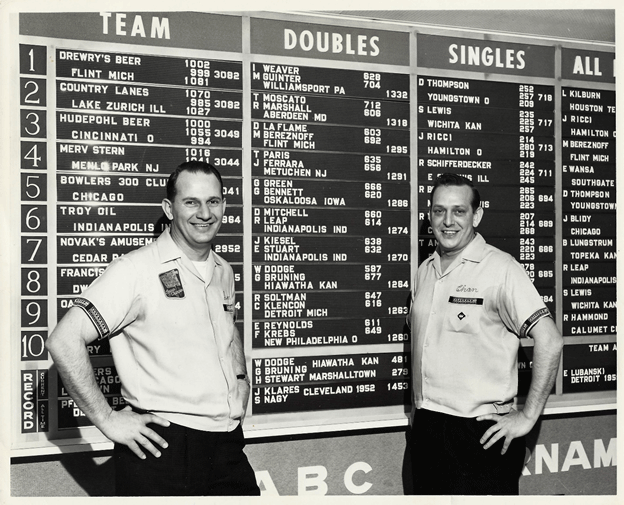
Mark Guinter and Pete Weaver stand in front of the Leader Board at the ABC National tournament after they move into first place in the Doubles Event.
The VFW Post in Muncy discontinues league bowling on its 2 lanes, built in 1943, a fate that continues to befall many of the small establishments during the 1960’s in the wake of the automatic pinsetter revolution of the 50’s. Installation of automatic machines on less than 10 lanes was apparently not cost effective and patronization of “pin boy” houses was on the wain.
The Williamsport Women’s Bowling Association elects its first Board of Directors from its overall membership, and begins regularly scheduled meetings. Prior to this time, the women’s association was governed by its elected officers plus the officers of all leagues under its jurisdiction, and held meetings only when a problem occurred in one or more of these leagues.
1962 The Youth Bowling Association (YBA) is formed by the Bowling Proprietors Association of America (BPAA).
1963 – In the spring of 1963, the Williamsport Bowling Association hosts its first Pa State Bowling Association Championship Tournament, after a savvy local delegation wins the bid at the State Convention in 1960. Teams from all over the state try their luck and their skill on the Harvest Moon and the ABC Lanes. Highest finishes among local bowlers include Ed Holcombe who wins the Scratch All Events title and finishes 8th in the handicap singles event.
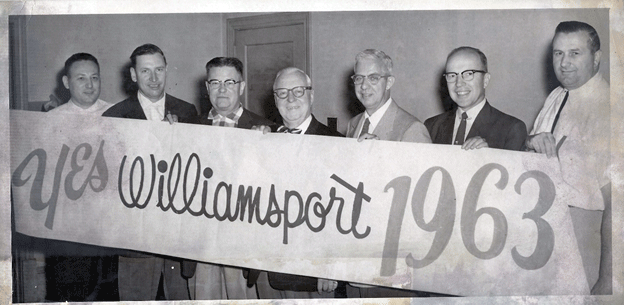
The local delegation to the State Convention that won the bid to bring the 1963 State Tournament to Williamsport. L to R: Jack Stine, Nelson Silverstrim, Tommy Barger, Tommy Richardson, Marr Heilhecker, Henry Parsons, and Morrie Agostinelli
In an effort to upgrade the image and appeal of bowling, the American Bowling Congress officially declares that Bowling Establishments and the surfaces therein over which bowling balls roll, will no longer be refered to as “alleys”, but will henceforth be called “lanes”; and that the term “gutter” will be changed to “channel”. This verbal refurbishment may have been occasioned by the replacement of pin boys with automatic pinsetters concealed by modern facades. Although the term “lane” became the predominate term, “channel” never seemed to catch on.
1964 – Local Bowling swells to 118 Leagues sanctioned by the WBA, the most ever.
1965 – The 10 lanes at Community in Montgomery close after 15 years of operation, due to a fire.
1966 – On April 4th and 5th, nineteen-year-old left hander John Wilcox moves into first place in All Events at the ABC National Tournament in Rochester, NY. His 2004 score held up through the close of the Tournament, enabling him to nail down the first and only ABC National Tournament Championship by a Williamsport bowler. Later that year, Wilcox, who would join the Pro Bowlers Tour in the 1970’s, and be elected to the National Bowling Hall of Fame in 1997, went on to win the Tournament of the Americas in Miami, as well as the World Title in London, England, his ABC All Events Title gaining him entry into the Tournament of the Americas, and his championship in that tournament gaining him entrance into the World Title Tournament.
The first honor score in the history of the local Association Championship Tournament is achieved by Ray Burkhart when he rolls a 299 game.
1967 – The six basement lanes at Turners on East Third Street are closed after just 12 years of operation.
The evening newspaper headlines on January 21 is a shock to any bowler who had not already heard the news. Early that morning, the Faxon Bowling Lanes on East Third Street, built just eight years earlier, were engulfed in a fire which consumed everything. Managing part owner, Bill Walsh vows to rebuild, and by the end of the year a new Faxon Lanes springs up on River Avenue. With 24 lanes, the new Faxon Lanes becomes and still remain the largest bowling establishment in the Lycoming County area.
The WBA Hall of Fame is established, with 6 Charter members being enshrined. New members were inducted each year thereafter at the Association’s annual meeting until 1992, when the first President’s Dinner, including Hall of Fame inductions along with the handing out of other awards, was held.
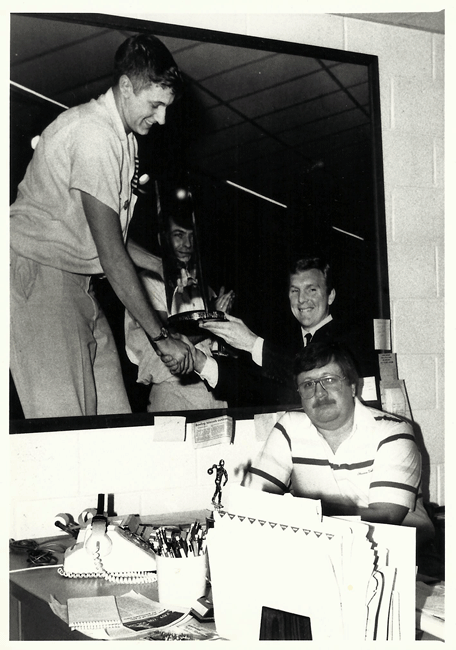
John Wilcox sits at his desk at his Mifflinburg Lanes in 1991, underneath the photo of him receiving his World Championship trophy in 1966 in London, England.
The Williamsport Bowling Association produces it’s first yearly average book, as mandated by the ABC at its national convention. The yearbook is printed every year thereafter, except perhaps for 1969 apparently, a year for which no existing book can be found. Few leaders seem to appreciate the historic value of these books however, and few copies survive into the 1990’s.
What about the women ?
1967 – The WBA initiates the annual designation of the Most Valuable Bowler, a yearly honor that lasted for 18 years before it is discontinued after the 1984 season.
In April, at the ABC Tournament site in Miami, local bowling great, Thomas S. Barger, Sr. is elected Grand King Pin (President) of the 700 Club of America. Installed by the legendary Andy Varipapa of Plainview, New York, Barger becomes the 13th Grand King Pin of the organization which had 23,348 members in 83 chapters in the country. Barger holds the post for two seasons.
1968 – Williamsport Bowling Association Membership climbs to 4168 the highest ever.
1969 – On April 30, Lena Meckley bowls a sanctioned 701 series at the ABC Lanes, becoming the first local woman to break the 700 mark.
1970 to 1979
“The Local Association expands its territory ”
The local associations expand and get a new name to reflect the expansion. John Wilcox records a three-game series of national note. Williamsport is host to its second PSBA State Tournament. Ball manufacturing is revolutionized by a pro bowler experimenting in his basement.
1970 – The Williamsport Bowling Association initiates the annual All Star Team designation, in which five area bowlers are elected to that season’s team, based on performance. All Star Team honors were discontinued after the 1983-84 season.
1972 – On July 21, the Williamsport Bowling Association changes its name to the Lycoming County Bowling Association. This name change was occasioned by the recent absorption into the local association of the Jersey Shore and Muncy Lanes, which lie outside of the city limits. Dispite the same territorial expansion, the local women’s association maintained it original name, which would not change until the 2005-06 season.
The four lanes at Elks Lodge # 173 close at the end of the 1971-72 season.
On November 6, in the Parade of Stars League at the Williamsport YMCA, John Wilcox throws a magnificent 885 series on games of 287, 298, and 300. This score not only broke Joe Kittel’s 34-year-old Association record, but was also the second highest sanctioned series ever bowled in American Bowling Congress history up to that date, as well as the highest ever bowled by a left hander, a mark which stood for two decades. It remained the Pennsylvania State record into the 21st century. Locally, Wilcox’s record, bowled with a Brunswick Automatic Score ball, would stand until 2016.
Pro-Bowler Don McCune discovers that by soaking a ball in certain chemicals, the ball becomes softer and its hooking capacity therefore increases. This created a revolution in bowling ball manufacturing, resulting in an escalation in scoring that continues into the 2000’s. In order to control this new technology, the ABC introduces a new rule which sets forth the minimum hardness for the surface of a ball. Determined by measuring the surface of ball with a duromitor, hardnesses below the minimum were not allowed in sanctioned competition.
The Williamsport Women’s Bowling Association starts its Hall of Fame. Every spring thereafter the women’s association holds a banquet at which new Hall of Famers are inducted and other awards are presented to association members.
1974 – The County association hosts it second PSBA State Tournament.
1976 Montour Lanes opens with 16 lanes.
1979 – At the age of 31, John Wilcox becomes the youngest bowler to be elected to the local association Hall of Fame. The age requirements were set aside for Wilcox since he was leaving the Williamsport area to take over management of the Mifflinburg Lanes, and would have no more chances to add to his impeccable achievements as a member of the County Association.
The Women’s Association initiates an All-Star Team designation, which continues every year until 1986.
1980 to 1989
“AVERAGES AND HONOR SCORES SOAR”
The YMCA Lanes close, local bowlers enter State Hall of Fame, Woody Crist comes into his prime, and a local woman posts a perfect game.
Between 1935 and 1979, the local association saw a total of 44 perfect games, with more than one being rolled in only eight of those 35 seasons. After 1979, there was never a season in which less than four 300 games were recorded in the county, and they occurred in double digits in every season but one, and in some seasons would be above 50.
1982 – After 59 years of operation, first in the basement, starting with five lanes, and expanding to nine and then 15 lanes, before installing 18 lanes on the first floor, the YMCA closes the doors to its bowling facilities.
1983 – Woody Crist wins his sixth consecutive local association high seasonal average award, passing Joe Piccolo’s record of five consecutive hjgh seasonal average awards achieved in 1961. Crist would go on to finish with the high average in the local association a total of 17 times, his first award coming in 1970 and his last award coming in 1997.
1984 – On September 18, Jeannie Eiswerth becomes the first local female to bowl a sanctioned 300 game as she rolls 12 strikes in one game at Faxon Lanes. Eiswerth duplicates that feat a month later on October 15, also at Faxon, recording her second perfect game before any other local woman achieves her first 300
1987 – Automatic scorekeeping machines are installed at the Harvest Moon Lanes and Faxon Lanes. By 1994 all local lanes would have one form or another of these automatic scorekeeping systems.
1990 to 1999
“History Book Published”
The first local association History Book is produced, a local women rolls an 800 series.
1990 – Kevin Stabler rolls his sixth career 298 game on Oct 11, to tie the ABC National record for most 298 games.
1991 – Williamsport hosts the inaugural State Mixed Tournament with local bowler, Stan Chaya,Sr, as the Tournament Director. Chaya, the Treasurer of the State Association, would continue as the Director of this Tournament until 2004.
The “Excalabular” becomes the first resin bowling ball to be released.
1992 – On March 11, local youth bowler, Kyle Renninger, at the age of 13 years, one month and four days, becomes the youngest bowler to post an 800 series, when he bowls an 802 in the junior bowling program at Faxon Lanes.
Woody Crist rolls his thirteen career 299 game on Nov 3, to tie the ABC National record for most 299 games.
The County Association holds its first President’s Dinner, including Hall of Fame Inductions and the awarding of seasonal honors to other association members. Prior to this Dinner, these inductions and award presentations had been made at the Annual Association meeting.
American Legion Post 1 – October – first history Display- Woody Crist.
1993 – On March 21, Newell’s Bombers (Mike Kessler, Lesa Traister, Betsy Zimmerman and Newell Thompson), a local team bowling WHERE? sets a new National record for four-person mixed teams for series and game, with a 2895 team series and a 1044 team game.
1994 – Local bowler, Danny Herbst is elected the 56th PSBA President.in July. The local association hosts his testimonial dinner at the Genetti Hotel.
On August 29, the first night of the new bowling season, Sue Delaney becomes the first local female bowler to roll a sanctioned 800 series when she knocks down 815 pins at Harvest Moon Lanes.
The 30th annual PSBA State Seniors Tournament is hosted by the local Association at Faxon and Montour Lanes in the Fall.
On November 11, Dave Miller sets the local association record for most consecutive strikes with 29, only to see his record tied by 17-year-old Kelle Renninger six days later on November 11, when she rolls an 838 series at the local ABC Lanes in the Thanksgiving Junior Bowling Team Tournament, on games of 300, 300 and 238. Her series sets a National YABA (Youth Alliance Bowling Association) female series record which would stand for 6 years. Kelli became the first bowler, male or female, in Lycoming County, to bowl two perfect games in the same series.
On December 19, Woody Crist rolls his 6th 298 game to tie the national record that Kevin Stabler tied in 1990. Crist throws his 15th 299 game on December 30 to set the ABC national record for most 299 games.
1995 – Woody Crist is inducted into the PSBA Hall of Fame at age 47, the fourth local bowler to be accorded that honor. Mike Bankert becomes the first male to bowl two 300 games in the same series, on September 22 at the ABC Lanes.
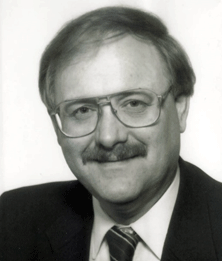
Woody Crist, original author of this history booklet in 1996.
1996 – The County Association puts out a 35-page history booklet detailing the first 100 years of bowling in the local area. The booklet, the first of its kind locally, was written by Woody Crist, who put in hundreds of hours of research at the local Library, as well as picking the memory of the oldest knowledgeable bowlers in the area. Entitled “’96 First History &Record Booklet”, the booklet contained a general history of bowling in the Williamsport area since its inception in the mid 1890’s, as well as the history of the County Association, particularly, through the 1950’s, and many bowling achievements by local bowlers from the 1920’s to the mid 1990’s, including all honor scores, many County Association records, seasonal award winners, and all County Association Annual Tournament winners. The booklet was dedicated to the first local Association President, David E. Gross and “Fosterer of the Sport,” Thomas S. Barger, Sr.
1997 – On February 13 in the Williamsport Major league, Susan Klopp and Kim Hamilton become the first women in WIBC history to each bowl a 300 game in the same game on the same team.
1999 – On March 20, the County Association teams up with the Williamsport Women’s Association to hold a joint Hall of Fame Banquet in the main Ball room of the Genette Hotel. . These annual joint banquets continued until 2016, at which time, the two associations decided to hold separate banquets for several years before merging together into the new USBC merged association, for the 2018-19 season, precipitating one association Hall of Fame Banquet. However, the merged association decided not to elect new Hall of Fame inductees for the 2018-19 season due to the fact that new rules for election had not yet been determined. The pandemic of 2020 forced the cancelation of that year’s banquet, and the first Hall of Fame Banquet for the newly merged Association would not be held until June of 2021.
2000’s
“USBC and Sport Leagues Begins”
The first decade of the 21st century sees the merger of the ABC, WIBC and the YBA into the USBC.
2002- The County Association teams with Williamsport Women’s Association to host the PSBA State Mixed Tournament at Montour Lanes during the summer.
2005 – The USBC (United States Bowling Congress) is formed with 2005-2006 being its inaugural season, as the ABC (American Bowling Congress), which sanctioned males, and the WIBC (Women’s International Bowling Congress) which sanctioned females, merge into one new Congress, which also includes youths. The jurisdiction of both of the old Congresses extended beyond the borders of the United States, and was thereby prohibited from entering teams in the Olympics, if and when bowling became an Olympic sport. The new United States Bowling Congress was limited to the national boundaries of the United States, therefore enabling the Congress to enter bowling teams in the Olympics. Prior to 2005, men’s and women’s competitions were entirely separate except for the fact that mixed leagues in which WIBC sanctioned women, and ABC sanctioned men were allowed to bowl in the same league with specific league rules specifying the male and female makeup of each team. Under the USBC, all bowlers were equally sanctioned, allowing any number of males and females to bowl on the same team in a league, except in the instance of leagues that were designated as women only leagues, and leagues in which the league rules specified the number of males and the number of females necessary to create a legal lineup. All male and female associations at the state and local level were urged by the USBC to merge into one association, but many did not do so, but remained separate USBC associations. In the Williamsport area, the two associations chose not to merge but remained separate as the Lycoming County USBC Bowling Association and the Williamsport Area USBC Women’s Bowling Association, with the County Association allowing female members but the Women’s Association being limited only to females.
2006 Montour Lanes close
2007-08 – The USBC creates the Sport League designation. The Sport league designation requires the oil pattern to be in a range which lowers averages and scores. There are several oil patterns each of which must be but out in each league for so many weeks during the season. Faxon Lanes opens a Sport League with about 4 bowlers participating. The following season, the Friday Night Three-Man Major League at Harvest Moon converts to a Sport League. The USBC develops a chart to convert a sport League average into an adjusted average to enable sport League Bowlers to fairly participate in tournaments with non-Sport League bowlers. At the 2010 USBC National Tournament, the USBC finally announces that it has been using a sport shot for the previous four years and will do so from that point on.
2009
On February 20, Mike Kessler becomes the first local bowler to bowl a 300 game under the Sport condition. In November of 2013, Kessler rolls his second 300 game under the sport condition, before anyone else manages to bowl one.
Nationally, bowlers begin to bowl with balls without a thumb hole, enabling more rotation on the ball. Some bowlers who don’t have the strength to do this with only one hand, adopt an approach in which the second hand holds the ball at the bowler’s side until the ball is released.
2008-09 – ABC Lanes closes its doors, but manages to reopen for the 2010-11 season
2010’s
2010 summer – Co. Association hosts State Mixed tournament at Faxon Lanes
2013 Cloverleaf closes at the end of the 2012-13 season. The property is bought by the Muncy Valley Hospital and the building is torn down that summer to make way for a parking lot. Few Cloverleaf bowlers move to other houses, and local association membership continues to spiral downward. Over the next several years, several leagues in other houses decide not to sanction because the USBC is cutting back on honor score awards.
2014
In the fall of 2014, the county association host its first ever PSBA State Senior’s tournament, with the Team Event taking place at Harvest Moon Lanes and the Doubles and Singles Events taking place at Faxon Lanes.
On September 9, Luke Hedgecook becomes the first area bowler to break the 800 mark under the sport condition, when he rolls an 802 series in the Harvest Moon Three Man Major League on Friday night.
2015-16 Last season for sports league. USBC discontinues official Sport League designation and recognition after 2015-16 season. But the Three-man Major League at Harvest Moon continues to use the sport shot even though the condition is no longer officially recognized as a separate designation.
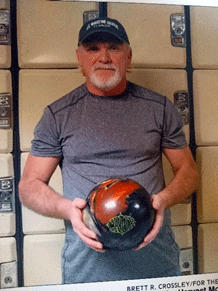
Dale Gerhard bowls 900 series
2016 On January 12, Dale Gerhard throws three consecutive perfect games in the Intercommunity League at the Harvest Moon Lanes, to record a 900 series. Gerhard became the first local bowler, and the 29th bowler in the country to achieve a 900 series, and, at the age of 59 years, 2 months, and 26 days, set a national record for the oldest bowler ever to do so up until that time. His series eclipsed the local association series record of 885 set by John Wilcox in 1972. His 36 consecutive strikes broke the previous local record of 29 set in 1994, and eclipsed the previous local most-strikes-in-a-series record of 34 set in 1992. His three consecutive 300 games broke the local record of two consecutive 300 games set in 1994. Ironically, each of these previous local records were held by different bowlers. Soon thereafter, Gerhard moved out of the local area.
2016 Fall The local association hosts the PSBA State Seniors Tournament, with the team event at Harvest Moon and Doubles and singles at Faxon. No Association tournament held that year.
2018 The County Association and the Williamsport Women’s Association along with the local Youth Association, merge into one association. This merger was required of all unmerged associations, by a resolution passed at the 2017 USBC National convention. The new merged association, officially known as the Lycoming County USBC Association is officially formed on 8/1/2018, with the 2018-19 season being its inaugural season. It should be noted that PSBA and the Pa State Women’s Association, along with the State Youth Association undergoewent a similar merger.
2018 Fall- County Association hosts the State Seniors Tournament with the team event at Harvest Moon and Doubles and singles at Faxon. This is the first State Tournament hosted by the newly merged local Association in its inaugural season. Due to hosting this tournament, no local Association Championship tournament was held.
2019 – In the fall of 2019, the weekly Kegler’s Korner newspaper article is revived, as local bowler, John Silverstrim receives permission from the Sun Gazzette Sports Editor, to produce the article each week during the bowling season. Silverstrim wrote the weekly article for more than five years.
2020 – Corna virus – covid-19 cuts the bowling season short as the Lanes are required to close by the Pennsylvania Governor’s orders in March of 2020. About 6 weeks were cut off of the winter season.
2020’s
2020 – Corna virus – covid-19 cuts the bowling season short as the Lanes are required to close by the Pennsylvania Governor’s orders in March of 2020. About 6 weeks were cut off of the winter season.
Due to the Covid -19 pandemic, the 2020 hall of Fame Banquet, scheduled for March, is postponed until June, and then canceled altogether. Inductees elected for the 2019-20 season would not be inducted until the 2021 Banquet.
2021 – County Association again hosts the State Seniors Tournament in the fall, with the team event at Harvest Moon and Doubles and singles at Faxon. Due to hosting this tournament, no local Association Championship tournament was held.
2023 – The County Association hosts the State Mixed tournament over the summer at Faxon lanes. Due to the hosting of the tournament, no local Association Championship Tournament was held for the 2022-23 season. This was the fourth time in 33 years that this State tournament was held in Williamsport.
After almost 50 years of owning and operating the Harvest Moon Lanes, the Miller family sells the Lanes. The lanes had been purchased by Vance Miller and his wife, Evalyn in 1972, and were being operated by their children at the time the Lanes were sold.
2025- The local bowling history booklet, originally produced in 1996, is subjected to editing, updating and expansion. Unfortunately, the original booklet only included history up until 1960, and was confined to County Association history, including little if any history of the local women’s association. After the merger of the County and local women’s Associations in the late 2010’s, under the auspices of the USBC, the material in the booklet was edited, the local women’s bowling history was added, pictures were added, and the material was expanded beyond 1960 and continues to be worked on to the present day, resulting in the material contained in this present document.
In the spring of 2025, the Lycoming County Association Website, bowllyco.com is created. This history along with all local records, achievements, and other information is being incorporated into this website.
